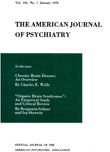REVIEW OF NEUROPSYCHIATRIC CASES IN THE SOUTH WEST PACIFIC AREA
Abstract
A study was made of cases observed on a neuropsychiatric service in a rear installation of the Army in the South West Pacific Area.
The psychoses were of greatest importance from the point of view of permanent loss of manpower. The possibility that environmental conditions peculiar to the area played an etiologic rôle was discussed. Atypical pictures were common. The impression was obtained that some of the acute cases might be essentially severe emotional reactions brought on by intense stress, perhaps representing "war psychoses" analogous to the acute war neuroses.
Among the psychoneuroses, anxiety states occurred with greatest frequency. In the acute conditions the stresses associated with combat played the most important etiologic rôle. In the more chronic cases previous neurotic tendencies were significant factors. Conscious attitudes and problems of morale influenced the picture in a considerable number of cases. Of the whole neurotic group, 69.1 percent of the patients were returned to duty.
Measures which might lessen the frequency of psychoneuroses and psychoses in the Army were discussed.
Brief mention was made of less common psychiatric conditions and neurologic disorders.
Access content
To read the fulltext, please use one of the options below to sign in or purchase access.- Personal login
- Institutional Login
- Sign in via OpenAthens
- Register for access
-
Please login/register if you wish to pair your device and check access availability.
Not a subscriber?
PsychiatryOnline subscription options offer access to the DSM-5 library, books, journals, CME, and patient resources. This all-in-one virtual library provides psychiatrists and mental health professionals with key resources for diagnosis, treatment, research, and professional development.
Need more help? PsychiatryOnline Customer Service may be reached by emailing [email protected] or by calling 800-368-5777 (in the U.S.) or 703-907-7322 (outside the U.S.).



